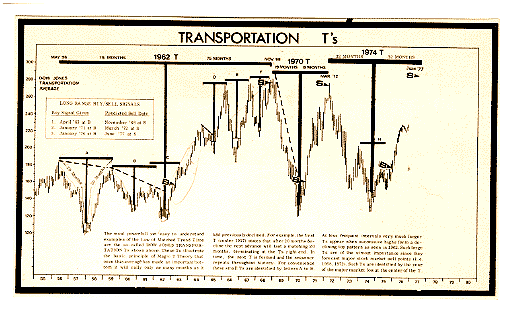Because this history captures all up trends, while correctly noting all important declines, I believe there is adequate evidence that a "natural law " is at work, which basically requires the market advances to match prior A-D Declines. It is important that we show this to be true for all the history above if it is to become the basis for our future work. I think the charts speak for themselves. I am satisfied that its insight will be a valuable tool for the future. In the months ahead we are awaiting completion of the current T which projects the run up for the December 1994 low to an October 1995 top, then development of the new 9th T with its projection of a top in mid 1997.ЁОНЛвзжЊЪЖmacd.org.cnЪеМЏећРэЁП
The larger version of the chart makes it clearer that the projected top dates are not precisely accurate. But as you would expect from a natural symmetry, the errors are equally distributed . Actually is doesn't matter much anyway. The maximum profits are easily seen as accruing from the center post of each new T and the maximum risk is easily seen as coming during the decline into what becomes the center post low of the next T. So our real task is to develop a method of anticipating the next T.
The Advance Decline T's Performance Summary
The table below summarizes the key characteristics of each graphical T in the prior chart. The cash build up duration in market days are, of course, defined with hindsight but the projected top date and gain figures are the logical consequence of the of the Matched Trend Time concept.
There are some consistent characteristics of these Ts which we may look to repeat in the future. However it should be kept in mind that the successive center post lows are theoretically allowed at random intervals so low pattern projections are subject to large errors. Nevertheless two important observations come out of the tabulated data. First, the most common place for a T's center post low is near year end or in the last quarter of the year.
In summary then, the history of Ts and the manner in which they evolve can be a unique and interesting way to watch market opportunities evolve. We need only to be patient as the current profit phase expires and a new cash buildup phase gets ready to fuel the next advance. We shall be following these potential scenarios in more detail.
A Theory of Matched Trend Time
Chapter 3 The Short Range Ts
In 1996 I undertook to apply the Theory of Matched Trend Time to a shorter time scale using more advanced techniques. The result are my Short Range Ts illustrated in the chart below.The theory of operation is similar to the Long Range Advance-Decline Ts except they make use of the Volume Oscillator to measure the Cash Build Up phase that defines the left side of each T. Essential the Volume Oscillator replaces the daily Advance-Decline Line which serves the same purpose for my Long Range Ts.
The chart above of my new Short Range Ts as of April 26, 1996 illustrate the key points of this short term refining tool. Along the upper portion of the chart is the trend of the NY Index which provides a measure of all 1800 stocks on the NY Exchange. The smoother green line is its 55 Day Moving Average which often market support during corrections. Many times the center post of the T, the ideal buying point, lies close to this moving average so it makes a handy reference point.
The Volume Oscillator plotted in Blue along the lower portion is an exponentially weighted volume oscillator of my own design and will be detailed in my 1996 Studies to be published in early 1997. Like any Oscillator, its trend fluctuates (or oscillates) above and below the neutral zero reading represented by the blue horizontal line which in this chart. When the Oscillator is well above the zero line the market is said to be overbought. When it is below the horizontal zero line, as it usually is at the center post low of a Short Range T, the market is said to be oversold.
The left side of any Short Range T is defined as the time during which the Oscillator has made a series of descending tops. The Declining tops trend is shown by the red line in the Oscillator plot. The period of declining tops is also shaded green so as to remind ourselves that a potential cash build up is taking place that can fuel a strong rally later on in the right side of the T. ЁОНЛвзжЊЪЖmacd.org.cnЪеМЏећРэЁП
The new T's rally should get underway when the declining tops trend line is broken to the upside. Most short term cash build ups last some few weeks ( typically 4 -7 weeks) and so these Ts tend to project rallies for the matching 4 to 7 week time span which I would consider as a "Short Term" projection. Compare the Daily Advance Decline Ts and you will see that the typical minimum for their cash build up is 8 months (35 weeks) which I think begins to qualify as a projecting long term advances of interest to investors.
In either case the Theory of Matched Trend Time requires that rally phases in the New York Index last as many days as the Cash Build Up in the left side of the T. The T centered on April 4 above illustrates the basic time symmetry. The February-March Cash Build Up period measures 63 days so this particular T projects a market peak some 63 days after the April 4 th center post low or a peak around June 6th.


